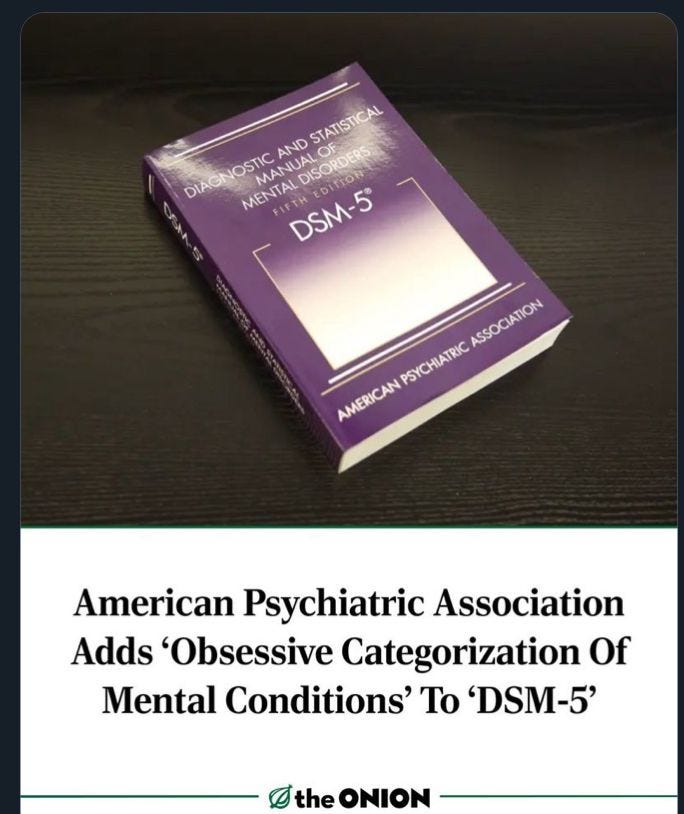The book in the amusing image above is the fifth edition of the Diagnostic Statistical Manual (DSM-V). It contains all the mental disorders that the American Psychiatric Association thinks we have.
When I first started working as a therapist, this book was very important to me. I used it as a doorstop.
I didn’t want my next client to face an unwelcoming closed door. So before each session, I jammed the door open. The DSM-V was so thick and heavy that it was perfect for the job. I’ve yet to find a better use for it.
Of course, when it was first published, it wouldn’t have been so helpful. The 1st edition, published in the 1950s, was just 32 pages long.
The DSM-V has grown to 947 pages worth of disorders. It seems the human race has gotten about 30 times more disordered in the past seven decades.
Or maybe the psychiatrists who come up with disorders make disorder categories up without any real scientific validity. Perhaps it’s easier to be an expert in the stuff you invent yourself. After all, homosexuality was listed as a disorder until 1973. Scientific eh.
It seems we can’t have struggles or personalities. We can’t have histories and experiences that shape how we see the world today. We can’t have emotional learnings that can be changed and updated.
No. We have disorders. Each human struggle categorised into some disorder or pathology. And of course, disorder suggests permanence - some messed up way that we just happen to be. Something to be managed at best. Something we are stuck with.
Some seem so downright offensive that, as the late Claude Steiner once observed, they may as well just call you an asshole.
Of course, I know people who have been assigned one of these labels and it has helped. Given that I also know many people who feel constrained and distressed at their diagnosis, I’m always interested in how the labels have helped.
Naturally, answers vary, but commonly I hear understandable stories of how the diagnosis helped make sense of their struggle. “Oh thank goodness. Now my struggles make sense - it’s because I have a disorder.”
Other times, it takes away the self harassment and self blame. It helps the person embrace that they are not at fault. Instead, they have a disorder, so can tread more gently with themselves. This in itself makes a huge difference.
I get this. It’s valid. And yet I also know that these yearnings for understanding, to make sense of our struggles, and to be free of self-blame are possible outside of the disorder model. And with a more accurate explanation of what is going on.
There are paths to making sense of our struggles that do not require us to be pathologised.
I am a therapist who has only ever used the DSM-V as a doorstop. Yet my practice is built on the assumption that our problems make sense, so let’s find out how.
Instead of a disorder model, we assume emotional learning. We assume that the very responses that cause us difficulties today also make protective emotional sense.
Crucially, it assumes that these responses are not crazy, disordered and maladaptive. Indeed, the very opposite. They are defences that were once utterly essential.
Think of the things that get in your way today that you’d like to change. Like the wallflower who quickly learned that being her exuberant self would bring disapproval from her parents. Or the hypervigilant, anxious man whose childhood saw him trapped in a household of domestic violence.
Were we not geniuses for developing these strategies to navigate the scary things in our young lives? Wouldn’t we have been in even worse trouble without them?
How can it be disordered to generate an ingenious self-protective strategy that successfully kept us alive? If that’s disordered, perhaps we need more of it.
Many people don’t want to have a disorder label imposed on them by a professional who believes, unscientifically, that they have some objective knowledge. Others find it helpful because of the reasons mentioned earlier.
I propose a pathology-free approach that honours the brilliance of our clients, helps them find the understanding they seek, and crucially delivers change, not management.
We are not disordered. We are not broken. We are childhood geniuses who made it through with strategies and responses that can now be safely updated. We can make sense of the world together from this non-pathologising standpoint and create transformation as a result.
The disorder model actively blocks the path to transformational change. It makes sense of our struggles by finding a disorder in a book, not by finding the emotional learning that can now be updated.
You are right to want to make sense of your struggles. There is a better way, and it leads you to a more accurate and transformational answer.


